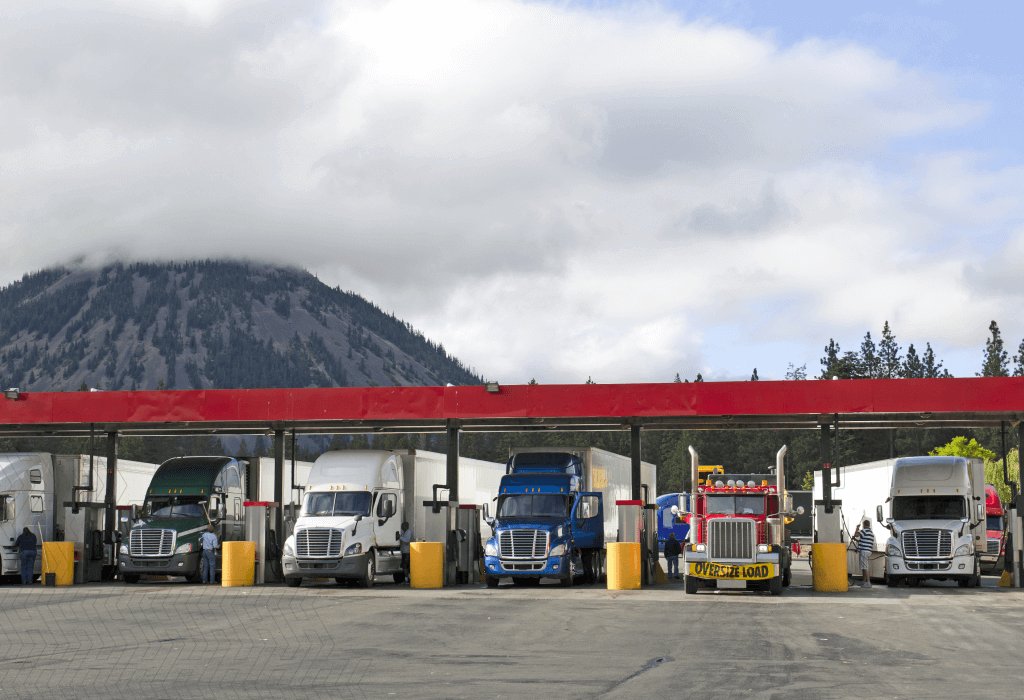21 Ways to Control Fuel Costs as an Owner-Operator

Save big on your
biggest expense.
Save up to $2 a gallon on fuel with the Truckstop Fuel Card.
Your number one expense as an owner-operator is fuel. And with diesel prices hitting record highs, it’s more important than ever to keep fuel efficiency top of mind.
While fuel costs are considered “fixed,” meaning they can’t be controlled, there are some actions you can take to optimize fuel consumption.
This guide has 21 tips to help you reduce fuel costs so you can keep growing your business as an owner-operator.
1. Use technology to find the best fuel stops.
The Truckstop Load Board offers owner-operators features like, Fuel Desk, which help identify the truck stop locations to fuel up route-by-route. Save on miles and money by allowing technology to tell you where and how much to gas up based on your average miles-per-gallon and the current diesel price.
2. Reduce your average speed.
Freight Brokers and shippers often encourage speedy travel, so it’s easy for a truck driver to fall into the trap of driving fast to appease them. Yet experts agree that speed is the main reason for increased fuel consumption and reduced profit. Your fuel mileage decreases once your truck passes its optimal cruising speed, which is around 60 mph. Even a slight decrease in your highway driving speed can help significantly, and only adds a few minutes to your travel time.
3. Limit the time spent idling.
Many drivers idle to power climate control and accessories at night. However, idling requires about a gallon of fuel per hour, which can really add up extra costs. Especially as the national average reaches $5.25 a gallon for diesel, according to a recent article in Transport Topics. Instead, look to invest in an auxiliary power unit which will pay for itself in no time.
4. Buy the right fuel.
In farming areas, it may be difficult to find ultra-low-sulfur diesel. Make sure to check labeling if you’re buying from any outlet that’s not clearly a truck stop.
5. Be careful with biofuel.
Biofuels tend to be more expensive and produce lower gas mileage. Know the level of biofuel allowed under your engine warranty, and use only approved fuels.
6. Maximize fuel tank storage.
Opt for larger dual tanks when buying a truck. This gives you the option of stocking up on super-cheap fuel when you can and cutting down on the number of stops needed.
7. Spec your truck wisely.
Think about weight and maintenance when selecting a truck. A big engine and heavy chrome may be tempting, but think about aerodynamics if you want a bigger paycheck.
8. Perform regular truck maintenance.
Keeping your equipment in tip-top working order will help it run smoothly and be fuel efficient. Start a preventative maintenance routine to check for low oil, a dirty air filter, or a compressor leak that could affect your miles per gallon (mpg).
9. Check your MPG regularly.
Divide the number of miles between stops by how much fuel you burned. Do it at every single stop and track it in your phone and a notebook you keep nearby. If it starts to change, figure out why. Many factors are outside of your control (weather is one example), but it’s important to stay in-tune to your truck.
10. Maintain tire pressure.
To reduce resistance, check the air pressure in all 18 tires and fill them up at least weekly to the manufacturer’s specifications.
11. Slow your acceleration and deceleration.
Save fuel, premature engine wear, driveline, and tires by losing the lead foot. Slowing acceleration is especially important running on hills because it helps reduce the effects of gravity.
12. Shift wisely.
If your engine is working harder to drive at a certain speed, you will burn more fuel. The trick is to use torque, not horsepower, to pull your load. Pulling with torque means you’re sustaining your speed without overworking the engine. A good sweet spot is around 1250 – 1350 RPM. Every truck engine varies, so check your owner’s manual or your truck dealer to understand your peak horsepower and torque at a specific RPM.

13. Optimize your route miles for efficiency.
Try rethinking your route, keeping side trips to a minimum, and using precise directions you’ll see a pay-off in savings. Load boards like the Truckstop Load Board provide carriers tools that help optimize routes from the start. Fuel Desk provides simple truck routing by controlling your travel miles with practical directions to save on miles and money.
14. Try a roof fairing.
Airodyne reports a full roof fairing that delivers just a 10% increase in fuel economy can save $6,900 a year. Even more basic flat-style roof fairings can deliver up to 5% in fuel savings.
A deep tread tire will have more rolling resistance when it’s new because it has more squirm in the tread. Low-rolling resistance tires have a more durable tread but at shallower depths.
16. Use active aerodynamics to reduce drag
Improving truck aerodynamics reduces drag and results in significant savings in fuel. Boost your truck’s efficiency by using devices to reduce the gap between the truck and the trailer, reduce airflow under the truck, and allow air to flow through slotted mud flaps to minimize fuel consumption.
17. Lighten up your wheels.
Yes, aluminum wheels can cost three times more than those made of steel, however most long-haul fleets use aluminum because the weight reduction is so dramatic. The resale value of aluminum wheels is retained for longer than steel wheels, too.
18. Add trailer side skirts.
Manufacturers say these devices can boost fuel economy by more than 5% and cost only $2,900 per trailer to install. Do the math to see how quickly they’ll pay for themselves.
19. Try getting a fuel surcharge.
Many carriers charge a surcharge when the national average price for a gallon of diesel exceeds a certain price. As long as you know your truck’s fuel economy, you can calculate how well a fuel surcharge compensates you for rising prices.
20. Understand low-fuel-tax states.
When you select your fuel stops, make sure you understand the difference between pump price and the real cost of the fuel without taxes. This might mean that the cheapest fuel is in the next state even though the pump price is higher. High tax purchases are settled up when you file your IFTA report.
21. Use the right lubricants.
Low-viscosity lubricants can improve fuel economy by about 2%, while the new formulations have been known to increase efficiency by up to 4%.
Better control your fuel costs with Fuel Desk
To make getting the maximum fuel efficiency even more attainable, the Truckstop Load Board offers Fuel Desk.
You can track your fuel consumption to get estimates and guidance for your suggested routes, pick the best fuel stops for your trip and so much more. Get a free demo to learn more.
Get helpful content delivered to your inbox.
Sign up today.
Find high-quality loads fast, get higher rates on every haul, and access tools that make your job easier at every turn.






